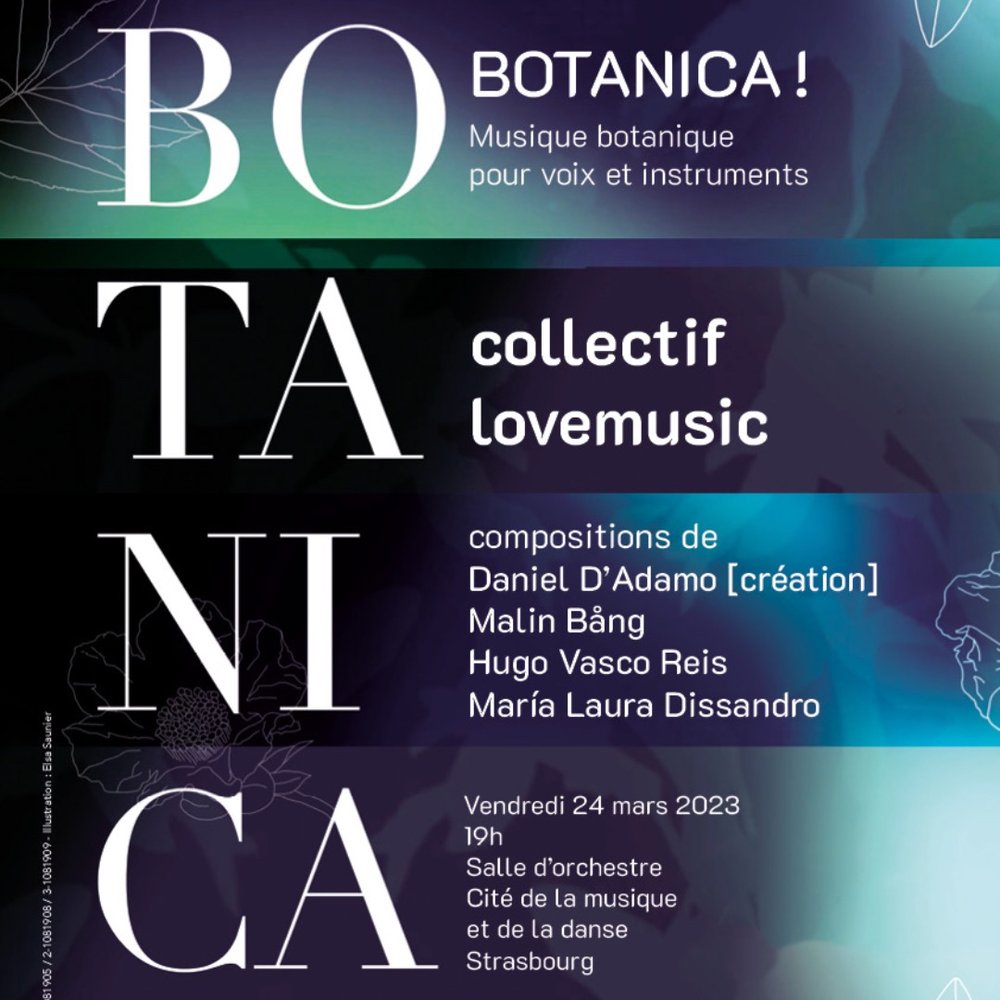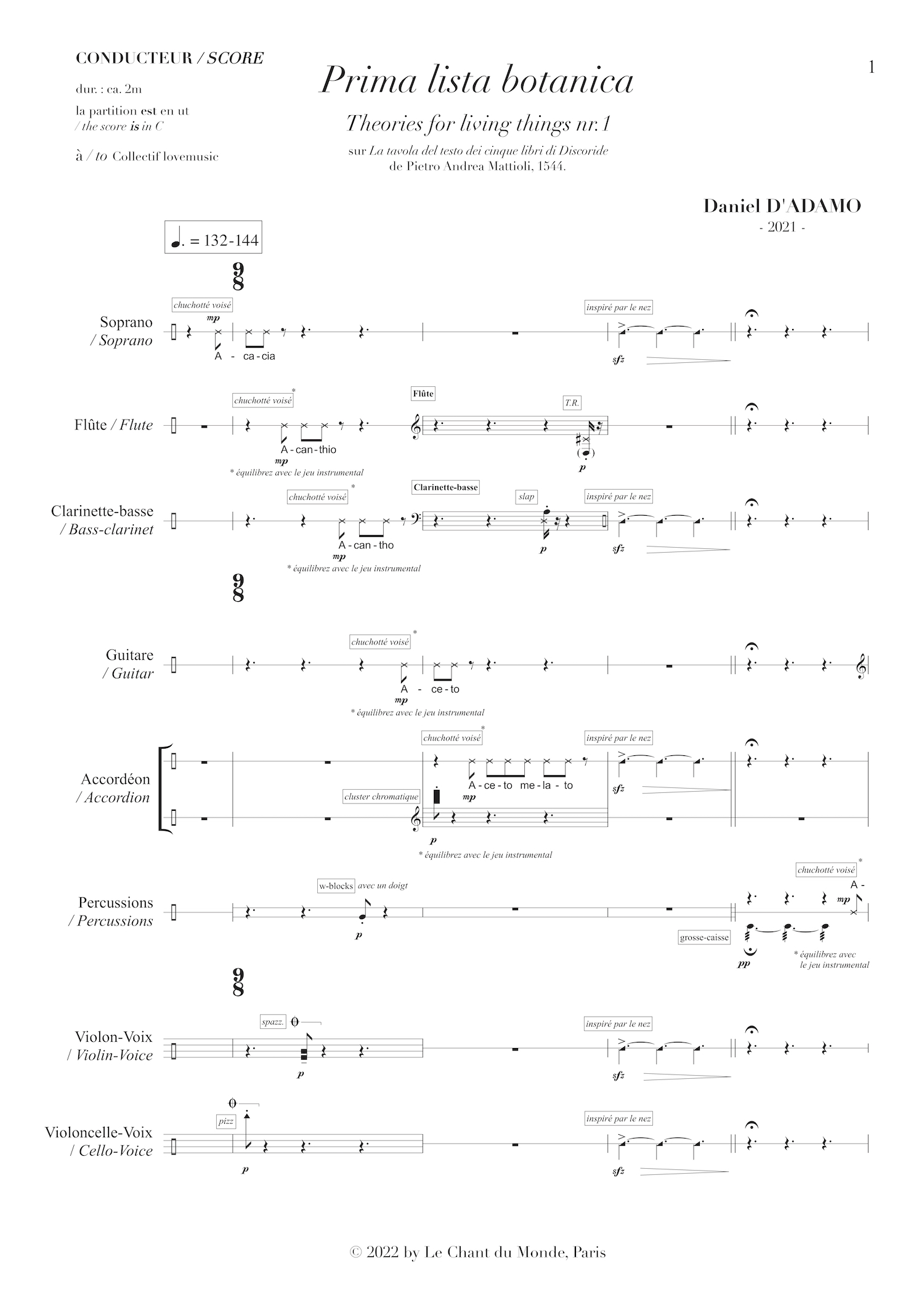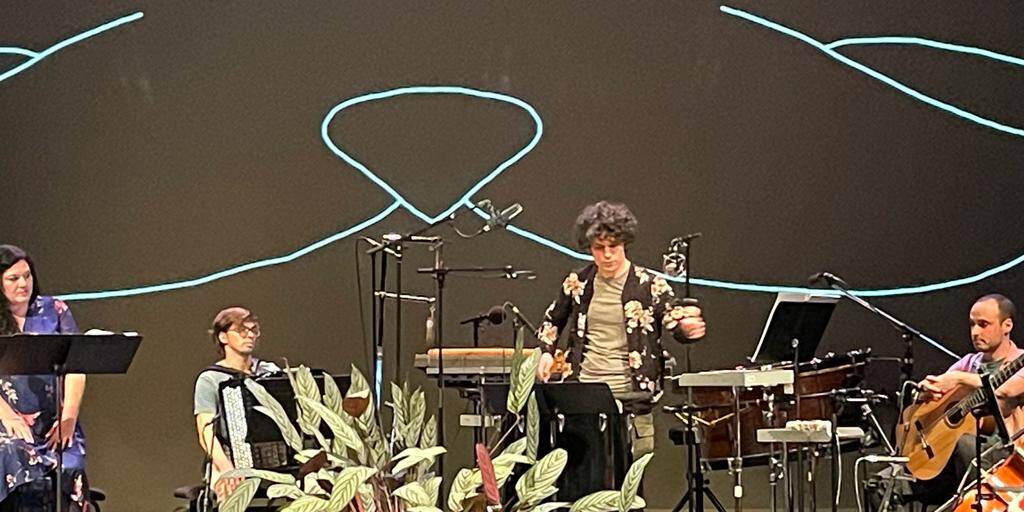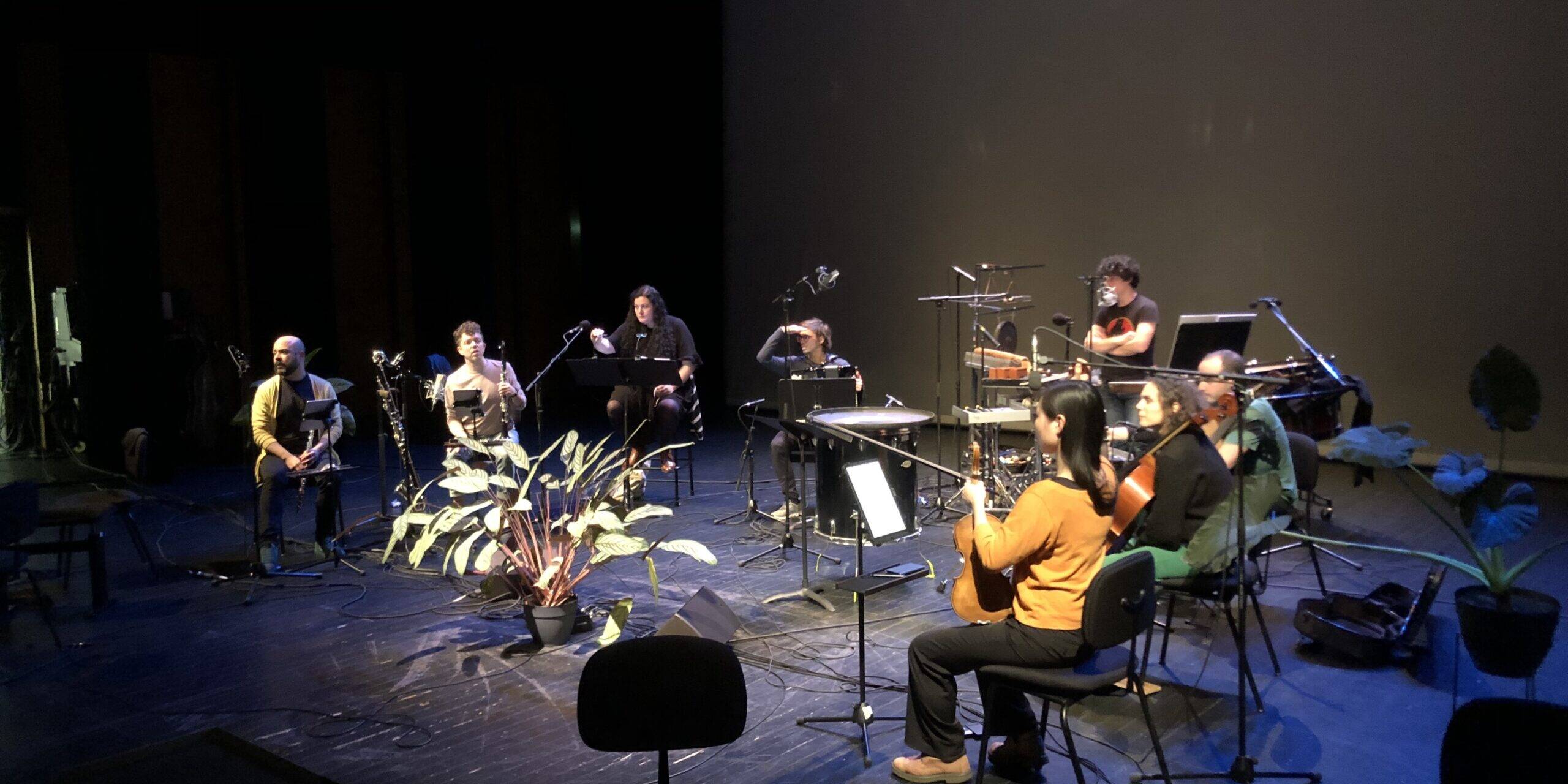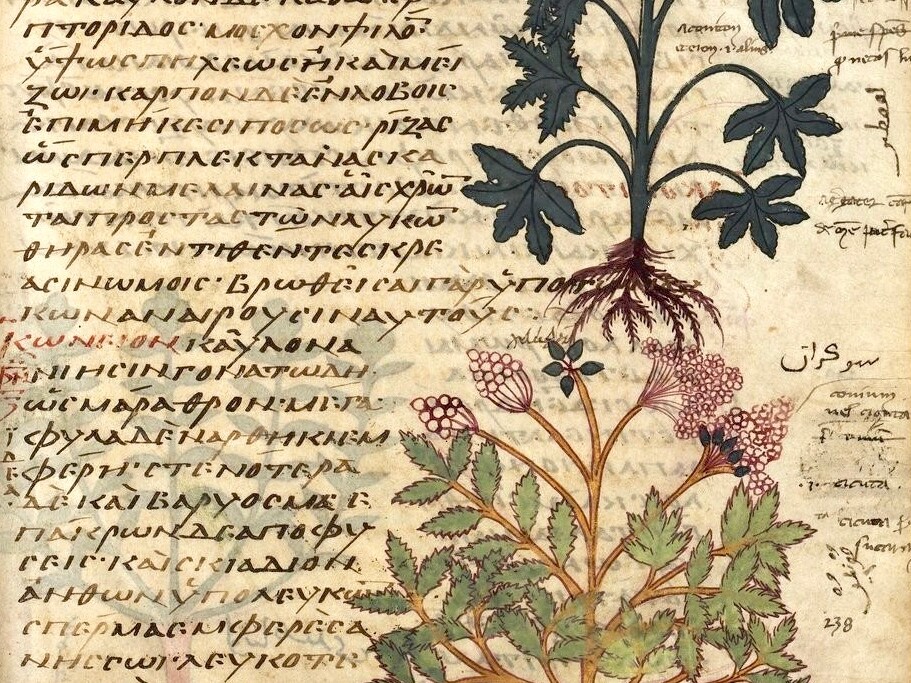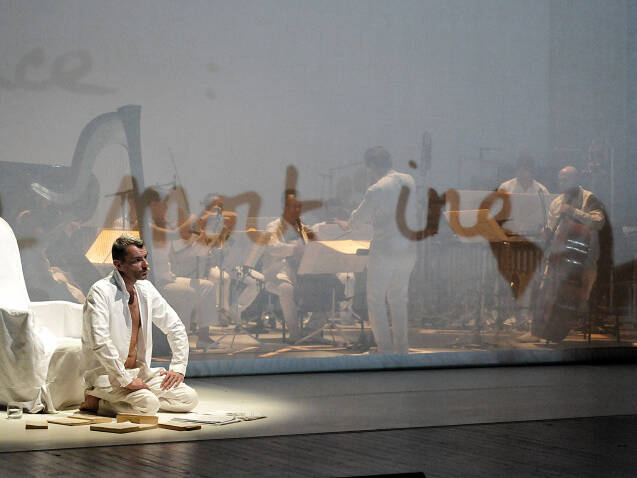Publisher:
Premiere:
2023, Collectif lovemusic, Cité de la Musique,
Strasbourg media
Year of composition
2023
Commission:
Ministry of Culture, France
Duration:
25 min
Theories for living things – 2023
for soprano, flute, clarinet, guitar, accordion, percussion, violin and cello
This cycle for voice and chamber ensemble is composed of four pieces whose themes are four plants of very different sizes and characteristics that have the particularity of establishing a unique relationship with the perception of time and sound, that is, with listening.
Five recitatives open and close the cycle and are interspersed between each of the four pieces. Nine songs, therefore, that celebrate plants.
Singing about the life of cacti, succulent plants with a unique power to resist extreme weather conditions that, above all things, demonstrate a very particular relationship with the perception of time. Cacti live in slow motion, as if frozen, imperturbable, impassive, stoic. They live in a temporality that is their own. By ingesting the pulp of certain cacti, the Kiowas, the Coras, the Tepehuanes, the Tarahumaras and the Huichols of Nayarit seek to acquire magical powers that may allow them to resist indefinitely, the passage of time.
Singing the Moabi, the tallest tree in the Central African canopy and a great percussion player : from a height of 80 meters it drops its fruits that hit the ground, thus producing intermittent low frequencies. A Morse code of plant origin is then generated, decipherable only by the elephants, who will then be able to enter the forest in search of the delicious fruits of the giant tree. This magical code is also decipherable by Pygmy hunters, who cover their bodies with Moabi bark dust to become completely invisible during the hunt.
Singing the Desmodium girans, also called dancing plants or Telegraphenpflanze : the only plants in the world that have … ears. They perceive sounds and react by shaking their leaflets, rotating on their axis, moving. In Bengal it is said that they “make their leaves dance like snakes” hypnotizing those who play or sing so they can see them dance.
Singing the giant water lily, the Victoria Amazonica. Its leaves are like immense skins stretched to the maximum, sound membranes : loud-speakers. They capture sounds coming from the air, amplify them and transmit them to the underwater world and vice-versa. The signals can be perceived by the small inhabitants of water and air, who thus learn of the existence of those who do not live in their own environment. The leaves of the Giant water lilies are exchange zones between two environments, rotating plates, acoustic-vegetal links.
The five recitatives – that open the cycle close it and separate each piece – methodically enumerate the vegetal elements, but also animals and minerals cited by Pedanios Dioskorides in his treatises De Materia Medica. Greek botanist, but also doctor and pharmacologist born between the 20s and 40s of the 1st century AD, in his work, Dioskorides methodically provides the information that allows each plant to be recognized and to understand what its properties are.
In 1544, the Siena-born physician and botanist Pietro Andrea Mattioli published in his botanical masterpiece Commentarii in libros sex Pedacii Dioscoridis the complete list of elements cited fifteen centuries earlier by his predecessor. This litany, translated by Mattioli into ancient Italian, is what the performers invoke in each recitative : the musician-healers then vest ancestral healing powers through plants and dispersing the effect of music.
Theories for living things is a commission of the French Ministry of Culture for the Collectif lovemusic.
Daniel D’Adamo
I – Prima Lista Botánica
II – Le Cactus
III – Seconda lista botanica
IV – Le Moabi
V – Terza lista botanica
VI – Desmodium gyrans
VII – Quarta lista botanica
I – Prima lista botanica
sur La tavola del testo dei cinque libri di Discoride
de Pietro Andrea Mattioli, 1544.
Acacia
Acanthio
Acantho
Aceto
Aceto melato
Achillea
Acino
Acoro
Aconato
Acqua
Acqua marina
Acqua melata
Adarce
Adianto
Agallocho
Agarico
Agerato
Aglio
Aglio salvatico
Agresto
Aiuga
Alcea
Alcionio
Alimo
Alipo
Alisma
Alibo
Aloe
Alfine
Althea
Alume
Amilo
Ammi
Amoniaco
Amomo
Ampellite terra
Ampelopraso
Amphodillo
Amagallide
Anagiri
Anchufa
Androface
Androfemo
Anetho
Anonide
Anthemide
Antherico
Anthillida
Antirhino
Antirhino
Antirhino
Apio
Apio montano
Apio palustre
Apios
Arabica pietra
Arabica spina
Arabide
Argemone
Aristolochia
Armeniache
Arthemisia
Asparago
Asphalto
Asphobelo
Aspleno
Assenzo Seriphio
Assenzo Santonico
Aster
Attico
Astragalo
Atramento librario, Sutorio, Overo Calcato
Atrattile
Atriplice
Avellane
Baccara
Balausti
Ballote
Barba di becco
Balsamo
Basilico.
—————
II – Le Cactus
Daniel D’Adamo
Plante grasse
Il stocke
Fait des réserves
Plante succulente
vit en léthargie :
n’a – van – ce pas
ne bou – ge pas
Il se bat
Il résiste …
Formes :
arborescentes
arbustives
colonnaires
grimpantes
globulaires
épiphytes retombantes
Tous au ra llen ti …
Pterocactus tuberosus … fixe
Echinopsis subdenudata … statique
Austrocylindropuntia floccosa … immobile
Cumulopuntia boliviana, Mammillaria albiflora … impavide … stoïque
Turbinicarpus subterraneus … imperturbable
Cephalocleistocactus chrysocephalus Eriosyce subgibbosa nigrihorrida … léthargique … inerte … impassible … languissant … inexpressif … amorphe … indolent
Isolatocereus dumortieri, Lophophora williamsii … freeeeeeeeze
Jikuli : Psy – cho – tropes.
Ayahuasca.
Phényléthylamine : Huichols du Nayarit
Anhalonidine : Kiowas.
Mescaline : Coras et Tepehuanes.
Lophophorine : Tarahumaras.
—————
III – Seconda lista botanica
sur La tavola del testo dei cinque libri di Discoride
de Pietro Andrea Mattioli, 1544
Balsamo
Basilico salvatico
Basilico acquatico
Bathrachio
Betta, overo bietola
Betonica
Brasica canina
Brasica marina
Brasica salvatica
Brionia
Brodo di pesci
Bromo
Bruchi
Buccine
Buglossa
Bulbo da mangiare
Bulbo vomitori
Bunio
Bunio falso
Buphthalmo
Bupresti
Cacalia
Calamintha
Calamo odorato
Calcifraga
Calcinaviva
Calli delle gambe de i cavalli
—————
IV – Le Moabi
à Diana
Daniel D’Adamo
Tombent
les uns après les autres
un bruit sec et profond
des très basses fréquences
des appels
dans la forêt tropicale
des subtones intermittents
sous-fréquences
ils les entendent tomber
de loin
ils trouvent l’arbre à fruits
loin dans la foret.
Les fruits tombent …
ils s’y précipitent à coups de défenses
ils les mangent
dispersant les graines
loin de l’arbre d’origine
sèment loin dans la foret
portent en soi les graines qu’ils sèment
loin très loin de là où les fruits tombent
deux-cents-cinquante grammes de fruits tombés au sol
les fruits du Moabi tombent les uns après les autres
depuis le plus haut de la canopée faisant un bruit sourd et sec.
Croissance rythmique
étages de branches horizontales
écorce épaisse, brun rouge
feuilles en étoiles
fleurs roses
puis rouge brique.
Lors d’une « yeyi »
les chasseurs pygmées enduisent leurs corps de poudre d’écorce du Moabi
et deviennent alors …
Totalement
invisibles.
—————
V – Terza lista botanica
sur La tavola del testo dei cinque libri di Discoride
de Pietro Andrea Mattioli, 1544.
Faggio
Fagiuoli
Fave
Fava d’Egitto
Feccia
Felce maschio
Felce femina
Fichi
Fichi secchi
Fichi grossi primaticci
Fiele d’animali
Fiore di rame
Fiore di sale
Fiori di Melagrano
Finocchio domestico, salvatico
Folio
Frasino
Fonghi
Fuligine di mirrha, e storace
Fuligine di ragia, di pesce, pittoria, d’incenso
Fumaria
Fumoterre
—————
VI – Desmodium gyrans
Daniel D’Adamo
C’est un arbrisseau qui perçoit.
Qui entend les sons : une telegraphenpflanze.
Il bouge peu à peu ses folioles, légèrement velus.
La nuit, il dort. Le jour … il danse.
Circumnutation.
C’est le mouvement entre la danse et le sommeil …
La marche est fortement sinueuse : zigzags nombreux, des boucles çà et là. Il tourne sur son axe, fait des contorsions, demeure immobile pendant un certain temps, puis, il tremble, s’agite en soubresauts, s’incurve, les faces supérieures des folioles tournées vers tous les points de l’horizon. Leurs extrémités décrivent des figures : une ellipse ou un ovale irrégulier, une sorte de spire.
En Bengale on dit qu’elle « fait danser ses feuilles comme des serpents ».
Dancing plant.
Telegraphenpflanze.
On frappe des mains … elles réagissent … elle bougent, tremblent : Tanzpflanze.
On parle, on chante, on chuchote … elles vibrent : pflanzliche Gesten.
On siffle … : Pfeifenpflanze.
Source : « La faculté motrice dans les plantes » ou « La puissance du mouvement dans les plantes », Darwin, Charles, 1882
—————
VII – Quarta lista botanica
sur La tavola del testo dei cinque libri di Discoride
de Pietro Andrea Mattioli, 1544.
Palma
Panace
Pancratio
Pane
Panico
Papavero cornuto
Papiro
Pepe
Pece secca
Peponi
Pera
Periclimeno
Pezzo
Phlaride
Phenice
Pietra
Pietra cadmia
(Pietra) Pomice
(Pietra) Pririte
(Pietra) Hematite
(Pietra) Thracia
(Pietra) Galactite
(Pietra) Melitite
(Pietra) Saphiro
(Pietra) Samia
Pirite pietra
Pistacchi
Poligala
Poligono
Polio
Polipodio
Polmone marino
Porro delle gambe dei cavalli
Procacchia
Pruna
Pruno
Quercia
Radice
Ragia
Rani
Rape
Rhu
Rosa
Rosmarino
Sale
Sangue di diversi animali
Scarpe vecchie
Sterco di cocrodilo.
I – Prima Lista Botánica
II – Le Cactus
III – Seconda lista botanica
IV – Le Moabi
V – Terza lista botanica
VI – Desmodium gyrans
VII – Quarta lista botanica
I – Prima lista botanica
sur La tavola del testo dei cinque libri di Discoride
de Pietro Andrea Mattioli, 1544.
Acacia
Acanthio
Acantho
Aceto
Aceto melato
Achillea
Acino
Acoro
Aconato
Acqua
Acqua marina
Acqua melata
Adarce
Adianto
Agallocho
Agarico
Agerato
Aglio
Aglio salvatico
Agresto
Aiuga
Alcea
Alcionio
Alimo
Alipo
Alisma
Alibo
Aloe
Alfine
Althea
Alume
Amilo
Ammi
Amoniaco
Amomo
Ampellite terra
Ampelopraso
Amphodillo
Amagallide
Anagiri
Anchufa
Androface
Androfemo
Anetho
Anonide
Anthemide
Antherico
Anthillida
Antirhino
Antirhino
Antirhino
Apio
Apio montano
Apio palustre
Apios
Arabica pietra
Arabica spina
Arabide
Argemone
Aristolochia
Armeniache
Arthemisia
Asparago
Asphalto
Asphobelo
Aspleno
Assenzo Seriphio
Assenzo Santonico
Aster
Attico
Astragalo
Atramento librario, Sutorio, Overo Calcato
Atrattile
Atriplice
Avellane
Baccara
Balausti
Ballote
Barba di becco
Balsamo
Basilico.
—————
II – Le Cactus
Daniel D’Adamo
Plante grasse
Il stocke
Fait des réserves
Plante succulente
vit en léthargie :
n’a – van – ce pas
ne bou – ge pas
Il se bat
Il résiste …
Formes :
arborescentes
arbustives
colonnaires
grimpantes
globulaires
épiphytes retombantes
Tous au ra llen ti …
Pterocactus tuberosus … fixe
Echinopsis subdenudata … statique
Austrocylindropuntia floccosa … immobile
Cumulopuntia boliviana, Mammillaria albiflora … impavide … stoïque
Turbinicarpus subterraneus … imperturbable
Cephalocleistocactus chrysocephalus Eriosyce subgibbosa nigrihorrida … léthargique … inerte … impassible … languissant … inexpressif … amorphe … indolent
Isolatocereus dumortieri, Lophophora williamsii … freeeeeeeeze
Jikuli : Psy – cho – tropes.
Ayahuasca.
Phényléthylamine : Huichols du Nayarit
Anhalonidine : Kiowas.
Mescaline : Coras et Tepehuanes.
Lophophorine : Tarahumaras.
—————
III – Seconda lista botanica
sur La tavola del testo dei cinque libri di Discoride
de Pietro Andrea Mattioli, 1544
Balsamo
Basilico salvatico
Basilico acquatico
Bathrachio
Betta, overo bietola
Betonica
Brasica canina
Brasica marina
Brasica salvatica
Brionia
Brodo di pesci
Bromo
Bruchi
Buccine
Buglossa
Bulbo da mangiare
Bulbo vomitori
Bunio
Bunio falso
Buphthalmo
Bupresti
Cacalia
Calamintha
Calamo odorato
Calcifraga
Calcinaviva
Calli delle gambe de i cavalli
—————
IV – Le Moabi
à Diana
Daniel D’Adamo
Tombent
les uns après les autres
un bruit sec et profond
des très basses fréquences
des appels
dans la forêt tropicale
des subtones intermittents
sous-fréquences
ils les entendent tomber
de loin
ils trouvent l’arbre à fruits
loin dans la foret.
Les fruits tombent …
ils s’y précipitent à coups de défenses
ils les mangent
dispersant les graines
loin de l’arbre d’origine
sèment loin dans la foret
portent en soi les graines qu’ils sèment
loin très loin de là où les fruits tombent
deux-cents-cinquante grammes de fruits tombés au sol
les fruits du Moabi tombent les uns après les autres
depuis le plus haut de la canopée faisant un bruit sourd et sec.
Croissance rythmique
étages de branches horizontales
écorce épaisse, brun rouge
feuilles en étoiles
fleurs roses
puis rouge brique.
Lors d’une « yeyi »
les chasseurs pygmées enduisent leurs corps de poudre d’écorce du Moabi
et deviennent alors …
Totalement
invisibles.
—————
V – Terza lista botanica
sur La tavola del testo dei cinque libri di Discoride
de Pietro Andrea Mattioli, 1544.
Faggio
Fagiuoli
Fave
Fava d’Egitto
Feccia
Felce maschio
Felce femina
Fichi
Fichi secchi
Fichi grossi primaticci
Fiele d’animali
Fiore di rame
Fiore di sale
Fiori di Melagrano
Finocchio domestico, salvatico
Folio
Frasino
Fonghi
Fuligine di mirrha, e storace
Fuligine di ragia, di pesce, pittoria, d’incenso
Fumaria
Fumoterre
—————
VI – Desmodium gyrans
Daniel D’Adamo
C’est un arbrisseau qui perçoit.
Qui entend les sons : une telegraphenpflanze.
Il bouge peu à peu ses folioles, légèrement velus.
La nuit, il dort. Le jour … il danse.
Circumnutation.
C’est le mouvement entre la danse et le sommeil …
La marche est fortement sinueuse : zigzags nombreux, des boucles çà et là. Il tourne sur son axe, fait des contorsions, demeure immobile pendant un certain temps, puis, il tremble, s’agite en soubresauts, s’incurve, les faces supérieures des folioles tournées vers tous les points de l’horizon. Leurs extrémités décrivent des figures : une ellipse ou un ovale irrégulier, une sorte de spire.
En Bengale on dit qu’elle « fait danser ses feuilles comme des serpents ».
Dancing plant.
Telegraphenpflanze.
On frappe des mains … elles réagissent … elle bougent, tremblent : Tanzpflanze.
On parle, on chante, on chuchote … elles vibrent : pflanzliche Gesten.
On siffle … : Pfeifenpflanze.
Source : « La faculté motrice dans les plantes » ou « La puissance du mouvement dans les plantes », Darwin, Charles, 1882
—————
VII – Quarta lista botanica
sur La tavola del testo dei cinque libri di Discoride
de Pietro Andrea Mattioli, 1544.
Palma
Panace
Pancratio
Pane
Panico
Papavero cornuto
Papiro
Pepe
Pece secca
Peponi
Pera
Periclimeno
Pezzo
Phlaride
Phenice
Pietra
Pietra cadmia
(Pietra) Pomice
(Pietra) Pririte
(Pietra) Hematite
(Pietra) Thracia
(Pietra) Galactite
(Pietra) Melitite
(Pietra) Saphiro
(Pietra) Samia
Pirite pietra
Pistacchi
Poligala
Poligono
Polio
Polipodio
Polmone marino
Porro delle gambe dei cavalli
Procacchia
Pruna
Pruno
Quercia
Radice
Ragia
Rani
Rape
Rhu
Rosa
Rosmarino
Sale
Sangue di diversi animali
Scarpe vecchie
Sterco di cocrodilo.
________________________


